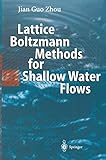Lattice boltzmann methods for shallow water flows [Libro electrónico] / Jian Guo Zhou
Por: Jian Guo Zhou [autor/a].
Tipo de material: Libro
en línea Editor: New York: Springer-Verlag Berlin Heidelberg, c2004Descripción: xi, 112 páginas : ilustraciones ; centímetros.ISBN: 364207393X; 9783642073939; 9783662082768 (Online).Nota de acceso: Disponible para usuarios de ECOSUR con su clave de acceso Nota de bibliografía: Incluye bibliografía: páginas 105-108 e índice: páginas 109-112 Número de sistema: 56725Resumen:
Libro
en línea Editor: New York: Springer-Verlag Berlin Heidelberg, c2004Descripción: xi, 112 páginas : ilustraciones ; centímetros.ISBN: 364207393X; 9783642073939; 9783662082768 (Online).Nota de acceso: Disponible para usuarios de ECOSUR con su clave de acceso Nota de bibliografía: Incluye bibliografía: páginas 105-108 e índice: páginas 109-112 Número de sistema: 56725Resumen:| Tipo de ítem | Biblioteca actual | Colección | Signatura | Estado | Fecha de vencimiento | Código de barras |
|---|---|---|---|---|---|---|
| Libros | Biblioteca Electrónica Recursos en línea (RE) | Acervo General | Recurso digital | ECO400567255783 |
Incluye bibliografía: páginas 105-108 e índice: páginas 109-112
Disponible para usuarios de ECOSUR con su clave de acceso
The lattice Boltzmann method (LBM) is a modern numerical technique, very efficient, flexible to simulate different flows within complex/varying geome tries. It is evolved from the lattice gas automata (LGA) in order to overcome the difficulties with the LGA. The core equation in the LBM turns out to be a special discrete form of the continuum Boltzmann equation, leading it to be self-explanatory in statistical physics. The method describes the micro scopic picture of particles movement in an extremely simplified way, and on the macroscopic level it gives a correct average description of a fluid. The av eraged particle velocities behave in time and space just as the flow velocities in a physical fluid, showing a direct link between discrete microscopic and continuum macroscopic phenomena. In contrast to the traditional computational fluid dynamics (CFD) based on a direct solution of flow equations, the lattice Boltzmann method provides an indirect way for solution of the flow equations. The method is characterized by simple calculation, parallel process and easy implementation of boundary conditions. It is these features that make the lattice Boltzmann method a very promising computational method in different areas. In recent years, it receives extensive attentions and becomes a very potential research area in computational fluid dynamics. However, most published books are limited to the lattice Boltzmann methods for the Navier-Stokes equations. On the other hand, shallow water flows exist in many practical situations such as tidal flows, waves, open channel flows and dam-break flows. eng
Disponible en línea
Disponible en formato PDF
Subscripción a ELSEVIER 26 de diciembre del 2013
